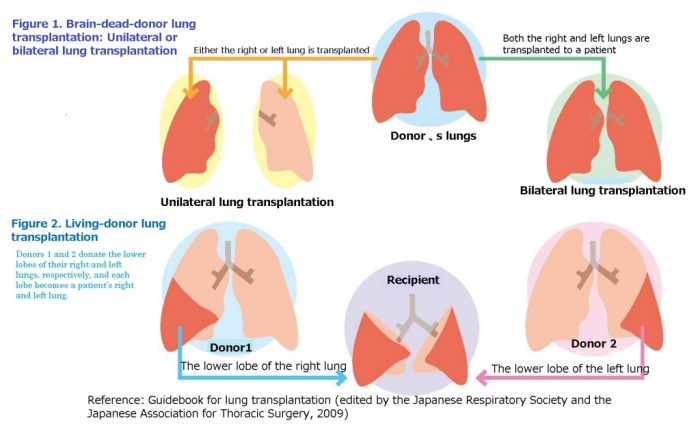Top > About Us > News Letter > Lung transplantation in the University of Tokyo Hospital
Lung transplantation in the University of Tokyo Hospital
Current medical practice at the University of Tokyo Hospital / The latest medical care
Department of Thoracic Surgery, Professor and Chairman, Jun Nakajima, M.D. & Ph.D.
The University of Tokyo Hospital was the first hospital in Tokyo to be approved as a lung transplantation facility in March 2014. In April 2015, the first living-donor lung transplantation was performed in a patient with progressive pulmonary fibrosis.
Living-donor lung transplantation is a special treatment in which a patient receives a part of the lung donated from two healthy individuals.
Here we introduce the details of lung transplantation and our approaches to lung transplantation in our hospital.
(1) What is lung transplantation?
Even nowadays, some lung diseases are progressive and intractable (which are not treatable with medications) with unknown causes. In these diseases, the most important function of the lung, namely gas exchange (in which oxygen in the air is taken into the body and carbon dioxide is released from the body), gradually becomes worse and this condition threatens a patient’s life. The most effective treatment for such diseases is lung transplantation, which is a surgical procedure in which a sick lung is removed and a new lung is transplanted. Currently, seventeen diseases listed in Table 1 are indications for lung transplantation in Japan. The indication is assessed by the criteria based on a patient’s age, medical state, and performance status as well as the type of disease.
Table 1. Indications for lung transplantation in Japan
- 1.Idiopathic pulmonary arterial hypertension
- 2.Idiopathic pulmonary fibrosis
- 3.Emphysema
- 4.Bronchiectasis
- 5.Pulmonary sarcoidosis
- 6.Pulmonary lymphangioleiomyomatosis
- 7.Eisenmenger syndrome
- 8.Other interstitial pneumonia
- 9.Obstructive bronchiolitis
- 10.Pulmonary eosinophilic granulomatosis
- 11. Diffuse panbronchiolitis
- 12.Chronic thromboembolic pulmonary hypertension
- 13. Multiple pulmonary arteriovenous fistula
- 14.1-antitrypsin-deficient emphysema
- 15.Cystic pulmonary fibrosis
- 16.Pneumoconiosis
- 17.Other progressive pulmonary diseases that are approved by the Joint Council of Societies for Lung and Heart-Lung Transplantation
(2) Brain-dead-donor or living-donor lung transplantation
Similar to the heart, liver, and kidney, brain-dead-donor transplantation is more commonly performed for the lung, in which a donor of the lung is a brain-dead individual. In this procedure, the whole unilateral or bilateral lungs are usually transplanted to a patient (Figure 1). On the other hand, in living-donor lung transplantation, the donors are two relatives of a patient who needs lung transplantation and a part of their lungs is transplanted to the patient (Figure 2).
Because living-donor lung transplantation requires surgery in two healthy individuals, this special treatment has to be performed only after in-depth investigation, including the adequate confirmation of the will of patient and donors, whether the surgery in the donors in particular can be safely performed, and whether the transplanted lungs can function normally after the surgery. The procedure requires a part (the lower lobe) of the left or right lung from two donors. The bilateral lungs are removed from the patient and the two lower lobes of the donors are transplanted.
(3) Lung transplantation facilities in Japan
In Japan, nine university hospitals, including the University of Tokyo Hospital, are approved as lung transplantation facilities (the other hospitals are affiliated with Tohoku University, Dokkyo Medical University, Chiba University, Kyoto University, Osaka University, Okayama University, Fukuoka University, and Nagasaki University). Because the number of organ donations after brain death is less in Japan than in other countries, the number of living-donor lung transplantations is relatively high in Japan. Both brain-dead-donor and living-donor lung transplantations are covered by health insurance in Japan.
(4) Living-donor lung transplantation in the University of Tokyo Hospital
The University of Tokyo Hospital was the first hospital in Tokyo to be approved as a lung transplantation facility in March 2014. In April 2015, the first living-donor lung transplantation was performed. The patient was a woman in her twenties with progressive pulmonary fibrosis. She had poor respiratory function. While she was hospitalized, she was not even able to get out of a wheelchair by herself, because she had difficulty in breathing even with oxygen inhalation. Two lower lobes of the right and left lung were donated from her two relatives, and we transplanted them to her. She made good progress after the surgery and she was able to walk around normally without oxygen inhalation as healthy people do. She moved to her local hospital for rehabilitation. After rehabilitation, she was discharged with a full recovery. We also performed the second lung transplantation to another patient in July 2015, which was the first bilateral lung transplantation from a brain-dead donor. The patient made good progress after the surgery and was discharged with a full recovery.
Lung transplantation is a new procedure in the University of Tokyo Hospital; however, because we have been promoting other organ transplantation, such as liver, kidney, and heart, clinical or other departments related to organ transplantation have been working in smooth cooperation. Using this advantage, we continue to provide medical care to patients living in Tokyo and the capital region who require lung transplantation.
The Department of Thoracic Surgery has a special outpatient clinic for lung transplantation, in which we accept referrals of patients who may need lung transplantation and we provide continuous long-term care in cooperation with the hospital that a patient is referred from so that the patient can live a healthy life after lung transplantation.

